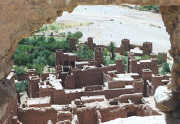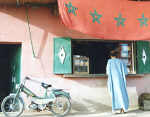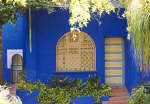The mystique of exotic camel safaris, magical Saharan desert sand dunes, swaying palm trees, and striking Moorish architecture compelled me to visit Morocco after experiencing it for the very first time as a child in Epcot’s World Showcase.
|
![]()
Traveling to exotic Morocco last July was finally a dream come true and never in my imagination did I think I would have a second opportunity to see this beautiful country again within eight short months of my first visit. As fate would have it, I met my Moroccan boyfriend Abdou on the plane ride from Casablanca to New York after returning from nine glorious days as a tourist in Marrakech and the High Atlas Mountains last summer.
This past February we went back to visit Abdou’s family and friends in his home town of Casablanca and ultimately, to spend a week touring the northern Imperial Cities of Fes, Meknes and Rabat. Needless to say, it was an incredibly edifying and eye-opening experience seeing his country from a local perspective.
What touched me more than anything else was the genuine hospitality of the Moroccan people. Considering the fact that the country is not much larger than the state of California, Morocco has over 28 million inhabitants, a diverse topography of mountains, fertile plains and desert; and some of the most stunning scenery in the world.
Once a French colony, Morocco still possesses heavy European influence in its people and architecture despite the fact that it is geographically located in northern Africa. During my extensive travels worldwide, I have never met people who welcomed strangers into their homes so openly and invitingly, and more importantly, their warmth and friendship truly comes from the goodness of their hearts. It was my mutual love and respect for the Moroccan people and my fascination with their culture that compelled me for a second visit.
Some helpful tips while traveling in Morocco
Air Travel
Royal Air Maroc is Morocco’s national carrier, and their U.S headquarters is located in Manhattan, New York. Since they do not accept credit card purchases over the phone, you will have to use a local travel agent for ticketing purposes. Reservations can be made directly at (800) 344-6726.
From Casablanca, it is imperative to check-in in order to continue to your next destination. Follow the signs through transit. Since there are no lines, no ropes, and no sense of order whatsoever, make sure to push your way to the counter. Otherwise passengers will cut in front of you without thinking twice. Be equally as aggressive and stand your ground. Have your plane ticket and passport readily available for the next agent.
Banks
The official currency is the dirham (DH). All banks offer the same exchange rate in a given day. One does not need to “shop around” for the best exchange rate like in most other countries. You will receive a more favorable return using cash vs. travelers’ checks or credit cards. In February 2000, the exchange rate was approximately $1US = 10.18DH.
Public Transportation
Scheduled trains and buses run frequently throughout Morocco, and is relatively inexpensive compared to our standards of transportation. Try to travel in first class where the enclosed train compartments are equipped for groups of six. First class accommodations cost approximately 20-30% more than second class. First class seats are spacious and clean, and up to par with what we are accustomed to. However they are not luxurious by any means. For deluxe bus travel, consider SupraTours coaches. The spacious seats recline comfortably, and the coach is equipped with air-conditioning. SupraTours has offices in all major cities and locations.
There are two types of taxis: petit and grande. Petit taxis travel only within the city limits. In all major cities, bargain a flat rate before getting in. Usually short rides cost approximately 10 DH, and longer rides should be no more than 30 DH. Keep in mind that rates double during the evening hours.
|
![]()
Grande taxis, usually in the form of old Mercedes sedans, are a suitable alternative for traveling from city to city. The downside is a full car of six including the driver is required. If your timing is off, be prepared to wait for a considerable amount of time prior to departure. Due to the tight seating arrangement, my boyfriend and I frequently paid for four passenger spots so that we would have the entire back seat to ourselves.
Hotels
If one person in your party is Moroccan, be prepared to show proof of marriage upon check-in. On a whole, the Moroccans are conservative and frown upon unmarried couples sharing a room and spending the night together. The exception to the rule is they are lenient with foreigners.
Secondly, single and double occupancy rates are listed on the back of each hotel room door. Be sure to check this information carefully because on two separate occasions, the front desk clerk charged me more than the actual going rate. Once I pointed this discrepancy to the manager, they would make a lame excuse and refund me the difference.
Food
For the most part, Morocco is a meat-eating country. Since most Moroccans are Muslims, you will not come across pork since it is against their religion to eat it. Staple foods include: harira (a hearty vegetable bean soup), couscous (finely ground semolina) with vegetables and meat; chicken tagine (a light stew made of lemon, olives and assorted herbs); pastilla (a flaky pastry crust filled with vermicelli type noodles and more often than not, pigeon); fresh fish; shrimp; lamb kabobs; escargot (snails); assorted vegetable & fruit salads; and excellent fresh squeezed orange juice.
Also, be careful of your intake of fresh produce. Stick with fruits that can be peeled. Although the fresh fruits and vegetables are hard to resist, remember that the foreign bacteria, water, and pesticides used can cause stomach aches and ultimately, vomiting and diarrhea.
By far, the best meals are of the homemade variety; however if you don’t get invited to a local’s home during your travels, try one of the many palace restaurants for a 4 or 5-course extravaganza. Palace restaurants don’t come cheap however, the average lunch may cost you $20-30, and dinner approximately $50-75 per person. When in Morocco, do as the Moroccans do. They eat with their right hand (not the left for hygienic purposes), and they are not afraid to dig in passionately.
Tourism
Morocco is extremely popular with Europeans, primarily the British, French, Germans, Italians and Spaniards. It is still a relatively new tourist destination for the U.S. market, so you will not encounter many Americans along the way. Also, don’t expect everyone to speak English.
Language
The official languages are the Moroccan dialect, the Berber dialect and Arabic. French is their official second language. In northern Morocco, Spanish is widely spoken. Lastly, English is seldomly spoken except by the educated class, or those who work in the tourism/hospitality industry. Most hotels will have at least one English translator on its premises.
Shopping
|
![]()
Shopping is invariably an exciting experience in Morocco. If you are a first-timer in the souks (marketplaces), it is advisable to hire a guide. The standard rate for an official guide is approximately $15 US per half day, and $25 US for a full day. An official guide carries his credentials and wears I.D on his breast pocket; he is also well versed in most languages, and provides strong knowledge and background in Moroccan history, culture and customs. The benefit is not only does the guide prevent you from getting lost in the narrow alleyways, but also he acts as bodyguard offering protection from the hustlers and storeowners whom want your business.
The multitude of local products is overwhelming: carpets, furniture, leather, silver, tea sets, wooden boxes, and pottery, are always safe bets. Bargaining in the souks is a way of life, and the vendors are pros at the game. Even though they can come across intimidating, you set the price tag, not them. I usually start around 15%, and never pay more than 25-30% of their initial asking price. Your goal is to act disinterested and be willing to walk away. My comment to them is, “Yes I like it, but I can do without.”
Believe me, if the price is right (and it usually is) the vendors will come chasing after you once you walk out of their store. If you prefer more upscale, one-of-a-kind pieces, there are numerous art galleries that offer treasures fit for a king. Once again, bargaining is expected even in the classiest joints.
For some reason shopping tends to be the most expensive in Marrakech, so you are better off making your purchases in Fes, Meknes, and Rabat. The Portuguese fishing village of Essaouira is known for its beautiful wooden artwork. Dollar for dollar, your money goes a long way regardless of where you shop.
Women & Dress
The Moroccan women, both young and old, generally wear caftans and djellabas. Both are long flowing robes available in various colors and styles; they are readily available in the marketplaces. The difference between a caftan and a djellaba is the latter possesses a hood.
In any place of worship, women are expected to cover their hair and bodies. No sleeveless shirts or short skirts are permitted. Shoes must be removed. However in the business districts and Ville Nouvelle (New City) where restaurants, cafes and nightclubs abound, women more frequently don western wear rather than traditional clothing.
Try to keep a sense of humor in this male dominated society. The reality of it is, it’s a difficult place for women seeking peace and solitude. Harrassment in the form of sales tactics, begging and sexual propositions can become incessant and annoying especially for solo travelers. The best thing to do is to ignore the comments and walk confidently to your anticipated destination.
Many men are merely curious, and are eager to strike up a conversation and practice their English. There were moments when I was glad I stopped to speak with the locals. It made my travels much more interesting interacting with them. Just use common sense and follow your female intuition.
Rarely will you see Moroccan women, let alone any women, sitting in cafes especially at night. The reason being, there are only certain ‘fashionable’ places where Moroccan women hang out without tarnishing their reputations. With the exception of western women or tourists, those local women who do hang out at the cafes are construed as prostitutes. Don’t be surprised if you receive propositions time and time again. For the most part western women are construed to be more liberal and open-minded, hence the propositions.
Rarely will you see members of the opposite sex holding hands. Don’t be surprised to see women holding hands, or even men holding hands for that matter. This action has nothing to do with sexuality, if anything, it is a sign of sisterhood or brotherhood.
Religion
Virtually all Moroccans are Muslim with the exception of a small Christian and Jewish population. The muezzins sound five times a day, so don’t be surprised to see people stop in their tracks for prayer. With the exception of the spectacular Hassan Mosque II in Casablanca, non-Muslims are forbidden to enter a mosque. All Muslims follow Ramadan, a one-month fasting period from sun up to sun down. This usually occurs around December, but the dates vary each calendar year.
Safety
|
![]()
Always exercise common sense. Leave your jewelry and valuables at home or in the hotel safety deposit box where they belong. Physical or bodily harm was never an issue during my travels, however be careful of pickpockets in the marketplaces. Carry enough cash to get you through the day, and keep the rest in a secondary location.
Unique Experiences Not to be Missed



